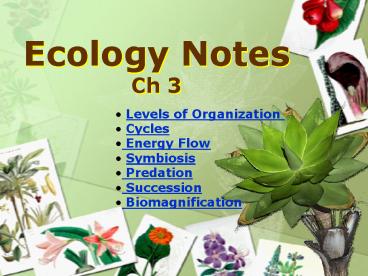Ecology Notes Ch 3 - PowerPoint PPT Presentation
1 / 55
Title: Ecology Notes Ch 3
1
Ecology NotesCh 3
- Levels of Organization
- Cycles
- Energy Flow
- Symbiosis
- Predation
- Succession
- Biomagnification
2
Ecology
- Is the study of interactions between organisms
with each other and their environment.
3
Levels of Organization
4
Biosphere
- All of the combined portions of the planet where
life exists, including land, water, and atmosphere
5
Biome
- A group of environments that share the same
climate. - Ex Desert, Tropical Rainforest, Savannah
6
Ecosystem
- All the organisms that live in a particular
place, together with their nonliving environment
Biotic Living ex owl, plant Abiotic
non-living ex sun, rock
7
Ecosystem
- Niche -All the physical and biological conditions
a species needs to live reproduce - Habitat- the area where an organism lives,
including the biotic and abiotic factors that
affect it.
8
Community
- Different populations that live interact in an
area.
9
Population
- A group of individual organisms that belong to
the same species and live in the same area.
Population of Elephants
10
Individual
- The different forms of life on earth
- Species
- Organisms that can breed produce fertile
offspring
11
Biosphere
Realm of Ecology.
Ecosystems
Communities
Populations
Organisms
Fig. 3-2, p. 51
12
Cycles
13
Biosphere
Nitrogen cycle
Phosphorus cycle
Carbon cycle
Oxygen cycle
Water cycle
Heat in the environment
Heat
Heat
Heat
Fig. 3-7, p. 55
14
Carbon Cycle- (see p. 77)
15
Nitrogen Cycle
16
Energy Flow
17
Energy Flow ? Producers
- Autotrophs - use solar energy or chemical energy
to make their own food
Photosynthesis
18
Energy Flow ? Producers
- Heterotrophs - get energy from the food they eat
- Herbivores eats plants
- Carnivores eats animals
- Omnivores eats plants and animals
19
Energy Flow ? Producers
- Heterotrophs - get energy from the food they eat
- Detritovores feed on dead matter (scavengers)
- Decomposers break down dead matter
20
Break it Down
- Auto self
- Troph feeding
- Photo light
- Synthesis make
- Hetero different
- -vore eat
- Herb plant
- Carni meat
- Omni all
21
ENERGY
STARTS WITH THE .
22
Energy Flow ? Producers
- The flow of energy in an ecosystem begins with
the sun. - Sun ? Producers ? Consumers ?Decomposers
23
Food Chains
- Shows feeding relationships between organisms
- Each step in the food chain is called a trophic
level.
Notice the arrows flow upward, showing the flow
of energy and who eats whom. Some Energy is lost
as heat at each level.
24
1st Trophic LevelProducersex. algae, grass
25
2nd Trophic LevelPrimary Consumer
herbivoresex. Grasshopper or a dear
26
3rd Trophic LevelSecondary consumer
carnivores or omnivoresex. Frog, bear
27
4th Trophic LevelTertiary consumer carnivores
or omnivores
28
Energy Flow ? Food Webs (complex chain)
- Show how energy nutrients move from one
organism to another through the ecosystem
29
Energy Pyramid
- Shows the amount of energy available at each
trophic level
ONLY 10 of energy is transferred at each level
30
STOP HERE!!!
31
Symbiosis
32
Interactions in an Ecosystem ? Relationships
- Symbiosis any relationship in which 2 species
live closely together - Mutualism
- Commensalism
- Parasitism
33
Types of Symbiosis
- Mutualism
- Both organisms benefit
- ( )
- Commensalism
- One organism benefits, the other is neither
helped nor harmed - ( 0)
- Parasitism
- One organism benefits, the other is harmed
- ( -)
34
Parasitism
35
Mutualism
36
Commensalism
37
Interactions in an Ecosystem ? Relationships
- Competition organisms of the same or different
species attempt to use the same resources at the
same time
38
Predation
- Predation - one organism hunts and eats another
- Predator hunter
- Prey organism that is eaten
39
Predator Prey Cycle
SOURCE Isle Royale Wolf/Moose Study GRAPHIC
By Patterson Clark, The Washington Post - July
21, 2008
40
Carrying Capacity
The maximum of individuals that a given habitat
can support
41
What is the carrying capacity?
42
Lower limit of tolerance
Upper limit of tolerance
No organisms
Few organisms
Few organisms
No organisms
Abundance of organisms
Population size
Zone of intolerance
Zone of physiological stress
Zone of physiological stress
Zone of intolerance
Optimum range
Temperature
Low
High
Fig. 3-11, p. 58
43
4 Factors Determine Growth Rate
- 1. Birth rate
- 2. Immigration
- 3. Death rate
- 4. Emigration
- Which increase and which decrease the population?
44
Limiting Factors
- Biotic or abiotic resource that limits size of
population
45
Habitat Needs
- Cover shelter trees, shrubs, etc.
- Water
- Nutrients
46
Population Growth
- Populations can grow until competition for
resources increases the carrying capacity is
reached
47
(No Transcript)
48
Succession
49
Succession
- The process where plants animals of a
particular area are replaced by other more
complex species over time.
50
Stages of Succession
- Land rock ? lichen ? small shrubs ? large
shrubs ? small trees ? large trees
51
Primary Succession
- When the starting point is an ABIOTIC environment
- Volcano
- Flood
52
Secondary Succession
- When an EXISTING ecosystem is disturbed
- Fire/lightning
- Disease
- Hurricanes
- Human activities
Credit Jeff Schmaltz, NASA's MODIS Rapid
Response Team
53
Wetland Succession
1
Wetland Succession Sedges and floating plants
close over the open water, trapping sediments in
their roots, and gradually drying out the pond.
2
3
54
Biomagnification
- Concentration of toxin at higher trophic levels
55
(No Transcript)































